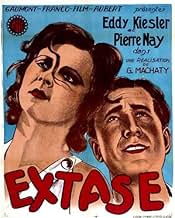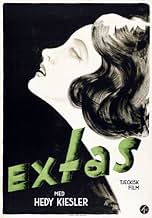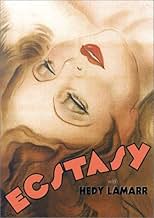AVALIAÇÃO DA IMDb
6,6/10
3 mil
SUA AVALIAÇÃO
Adicionar um enredo no seu idiomaEva has just got married to an older gentleman. She leaves him, and one day, she meets a young man, and they fall in love. Fate brings the husband together with the young lover that has take... Ler tudoEva has just got married to an older gentleman. She leaves him, and one day, she meets a young man, and they fall in love. Fate brings the husband together with the young lover that has taken Eva from him.Eva has just got married to an older gentleman. She leaves him, and one day, she meets a young man, and they fall in love. Fate brings the husband together with the young lover that has taken Eva from him.
- Direção
- Roteiristas
- Artistas
- Prêmios
- 2 vitórias e 1 indicação no total
Hedy Lamarr
- Eva Hermann
- (as Hedy Kiesler)
Emil Jerman
- Eva's husband
- (narração)
Antonín Kubový
- Landarbeiter
- (as Antonin Kibový)
Bedrich Vrbský
- Eva's father
- (narração)
Jirina Stepnicková
- Eva
- (narração)
Ladislav Bohác
- Adam
- (não creditado)
Comedian Harmonists
- Themselves
- (não creditado)
Kani Kipçak
- Dr. Brady
- (não creditado)
Karel Macha-Kuca
- Der Rechtsanwalt
- (não creditado)
Jirina Steimarová
- Typist
- (não creditado)
Avaliações em destaque
This was a very daring film for it's day. It could even be described as soft-core porn for the silent era. It was a talkie, but dialog was extremely limited, and in German. One did not need it anyway.
The young (19) Hedy Lamarr gets trapped in a loveless marriage to an obsessive (stereotype?) German and after a short time in a marriage that was apparently never consummated, returns home to her father.
In a famous and funny scene, she decides to go skinny dipping one morning when her horse is distracted by another. She is then forced to run across a field chasing after it, as she left her clothing on the horse. An engineer retrieves her horse and returns her clothing - after getting an eyeful.
They sit for a while and, in a zen moment, he presents her with a flower with a bee sitting on top. This is where she thinks back to her honeymoon and the actions of her husband and an insect. She knows this man is different.
She returns home and eventually seeks out our young fellow, and finds the ecstasy she was denied. You can use your imagine here, but his head disappears from view and we see her writhing with pleasure. Since he never got undressed, you can imagine... Certainly, an homage to women by the director Gustav Machatý, and a shock to 1933 audiences.
The only thing that mars this beautifully filmed movie is the excessive guilt, and a strange ending.
The young (19) Hedy Lamarr gets trapped in a loveless marriage to an obsessive (stereotype?) German and after a short time in a marriage that was apparently never consummated, returns home to her father.
In a famous and funny scene, she decides to go skinny dipping one morning when her horse is distracted by another. She is then forced to run across a field chasing after it, as she left her clothing on the horse. An engineer retrieves her horse and returns her clothing - after getting an eyeful.
They sit for a while and, in a zen moment, he presents her with a flower with a bee sitting on top. This is where she thinks back to her honeymoon and the actions of her husband and an insect. She knows this man is different.
She returns home and eventually seeks out our young fellow, and finds the ecstasy she was denied. You can use your imagine here, but his head disappears from view and we see her writhing with pleasure. Since he never got undressed, you can imagine... Certainly, an homage to women by the director Gustav Machatý, and a shock to 1933 audiences.
The only thing that mars this beautifully filmed movie is the excessive guilt, and a strange ending.
This early German talkie stars the gorgeous Hedy Lamarr as a bored hausfrau and is notorious for not only showing her in her birthday suit but also in the throes of passion. The film was banned in the US! For that reason alone, one should watch it. Lamarr is truly beautiful and offers a strong performance as the woman who falls for the security of an older man (and marries him) only to become restless and subsequently enthralled with a younger, more exciting lover.
This is romanticism in the original 18th and 19th century sense of exalting human emotion and imagination, depicting the nature of sex and human relations in terms of powerful, elemental forces mirrored and symbolized in nature. It's prototypical also of European art cinema, which I've always had a weakness for. A romance, yes, but not in the sense of some smarmy "relationship" flick. All that aside, it's just strikingly beautiful, and a real treat for people who relish earlier styles of film-making. On reading some brief blurbs about the new DVD edition before getting it, I kind of got the impression that it was some cheap "shocker" in the manner of "Sex Madness" or "Reefer Madness," which couldn't be further from the truth.
As has been remarked, it's practically a silent film with a continuous musical score. Released very early in the 1930s, I have to wonder if it wasn't originally conceived and largely shot as a silent, and retrofitted for sound. Spoken lines are never more than a brief sentence or two, and most often just one or two words. This is at a time when American films were thick with dialog, taking full advantage of the new sound technology. I think much of the communicative power of cinematography was shoved aside or forgotten with the advent of sound. Had this picture been done in the United States at that time, quite apart from the demands of the sensors, a continuous patter of verbal exposition and just plain yammering would have been insisted-on by those financing it. Thankfully, it wasn't, and we still have this almost-forgotten gem to show for it.
The direction and cinematography isn't really revolutionary for its time, as it uses techniques, camera tricks, editing and points-of-view that had already been invented by earlier pioneers of silent film, but their presence still makes it stand strikingly apart from the vast majority of mainstream films of the era. There is visual sexual symbolism obvious enough to raise a giggle or two from some modern viewers (Eva pensively toys with her ring while lying on the bed on her wedding night, one drooping flower drips into another receptively open flower after a violent rainstorm). It's hardly out of place, as sex is at the very center of the film.
The musical score is extremely specific to the action, and is highly lyrical. It may strike some modern viewers as a bit too cloyingly sweet, but I find it appropriate to the style and powerfully effective for getting you into the spirit of the piece. It helps evoke the wide range of mood in the film, which at the very start almost looks like a whimsical romantic comedy. The mood darkens considerably as it moves on.
A story is told powerfully and with great visual artistry, without any superfluous exposition or jabber. For me, it's the essence of cinema. It was a big surprise for me, and I'm grateful for the opportunity to finally see it.
As has been remarked, it's practically a silent film with a continuous musical score. Released very early in the 1930s, I have to wonder if it wasn't originally conceived and largely shot as a silent, and retrofitted for sound. Spoken lines are never more than a brief sentence or two, and most often just one or two words. This is at a time when American films were thick with dialog, taking full advantage of the new sound technology. I think much of the communicative power of cinematography was shoved aside or forgotten with the advent of sound. Had this picture been done in the United States at that time, quite apart from the demands of the sensors, a continuous patter of verbal exposition and just plain yammering would have been insisted-on by those financing it. Thankfully, it wasn't, and we still have this almost-forgotten gem to show for it.
The direction and cinematography isn't really revolutionary for its time, as it uses techniques, camera tricks, editing and points-of-view that had already been invented by earlier pioneers of silent film, but their presence still makes it stand strikingly apart from the vast majority of mainstream films of the era. There is visual sexual symbolism obvious enough to raise a giggle or two from some modern viewers (Eva pensively toys with her ring while lying on the bed on her wedding night, one drooping flower drips into another receptively open flower after a violent rainstorm). It's hardly out of place, as sex is at the very center of the film.
The musical score is extremely specific to the action, and is highly lyrical. It may strike some modern viewers as a bit too cloyingly sweet, but I find it appropriate to the style and powerfully effective for getting you into the spirit of the piece. It helps evoke the wide range of mood in the film, which at the very start almost looks like a whimsical romantic comedy. The mood darkens considerably as it moves on.
A story is told powerfully and with great visual artistry, without any superfluous exposition or jabber. For me, it's the essence of cinema. It was a big surprise for me, and I'm grateful for the opportunity to finally see it.
This is one that sent church and censors in disarray when it made its way to America, no doubt for the divorced woman who runs fully naked through the woods. The things people would be so uptight about, so tame to us now. But it introduced Lamarr to Hollywood.
A young woman then who yearns to be open to sense things, live life, but she's stifled by thankless marriage. The whole plot is typical, what they were calling kammerspiel in Germany, about the twists and turns of love, until the moral denouement that inevitably parts lovers.
But instead of narrowing down to a room and stage, it opens up sense to things, we have a poetry of evocative skies, nature, reflections, glances of the eye that conjoin a wider world. In many respects it might as well have been a silent, dialogue is scant.
And it does more than paint in fact, it paints the state of mind that gives rise to the pulls that create narrative. You'll see this in the famous scene mentioned above, where capricious horse nature sends her out to meet her mate. Or the marvelous scene later that night of anxiously being unsure if she wants to go to his house, rendered with wind through an empty house and dark rolling skies above.
It's simple in contrasts and goes down rather easy but dressed and timed to resonate. The ex husband languishing in an empty room while the lovers are greeted with music in the tavern next door. Love isn't allowed last say however as if that would be too upsetting for the social norm.
But something else is, more poignant eventually.
The ending shows a working site with tools strewn about, deserted at morning. But does life stop in its tracks because a woman left? We now see workers file in and joyously go to work, the work of doing is resumed with song, the ground transformed, a faucet turned on and waters of life pour freely. It's the most vital scene in the film, emulating the Soviet filmmakers but so good it's worthy of being in Zemlya.
A young woman then who yearns to be open to sense things, live life, but she's stifled by thankless marriage. The whole plot is typical, what they were calling kammerspiel in Germany, about the twists and turns of love, until the moral denouement that inevitably parts lovers.
But instead of narrowing down to a room and stage, it opens up sense to things, we have a poetry of evocative skies, nature, reflections, glances of the eye that conjoin a wider world. In many respects it might as well have been a silent, dialogue is scant.
And it does more than paint in fact, it paints the state of mind that gives rise to the pulls that create narrative. You'll see this in the famous scene mentioned above, where capricious horse nature sends her out to meet her mate. Or the marvelous scene later that night of anxiously being unsure if she wants to go to his house, rendered with wind through an empty house and dark rolling skies above.
It's simple in contrasts and goes down rather easy but dressed and timed to resonate. The ex husband languishing in an empty room while the lovers are greeted with music in the tavern next door. Love isn't allowed last say however as if that would be too upsetting for the social norm.
But something else is, more poignant eventually.
The ending shows a working site with tools strewn about, deserted at morning. But does life stop in its tracks because a woman left? We now see workers file in and joyously go to work, the work of doing is resumed with song, the ground transformed, a faucet turned on and waters of life pour freely. It's the most vital scene in the film, emulating the Soviet filmmakers but so good it's worthy of being in Zemlya.
10wndlz
This film could have been a silent movie; it certainly has the feel of one. I was extremely, extremely lucky to see this very rare version of this film. Extase, is a 'symphony of love', and transcends all language versions. French, which is the ultimate romantic language, seems quite suitable for this very sensual and lyrical version.A young Hedy Lamarr lights up the screen, in this film which, in a way is almost like a sex fantasy; but definitely far from being pornographic.Tech qualities may have been a little crude; but that does not detract from the magical spell this film exudes.Many lovers of early cinema, would absolutely adore this film.
Você sabia?
- CuriosidadesFirst surviving non-pornographic film to depict a woman having an orgasm.
- Erros de gravaçãoIn the beginning when Emil is in the bedroom, a closeup of the photo on the bedside table is shown to have writing on it. On the second closeup, when Emil is carefully rearranging his keys and other items, there is no writing.
- Citações
Eva Hermann: Tell him... no. Don't tell him anything.
- Versões alternativasTo get the film around the more conservative German censors, an alternate version of Hedy Lamarr's nude bathing scenes was shot in which she was partially obscured by strategically-placed bushes.
- ConexõesEdited into Histoire(s) du cinéma: Fatale beauté (1994)
Principais escolhas
Faça login para avaliar e ver a lista de recomendações personalizadas
- How long is Ecstasy?Fornecido pela Alexa
Detalhes
- Tempo de duração
- 1 h 22 min(82 min)
- Cor
- Mixagem de som
- Proporção
- 1.19 : 1
Contribua para esta página
Sugerir uma alteração ou adicionar conteúdo ausente



















